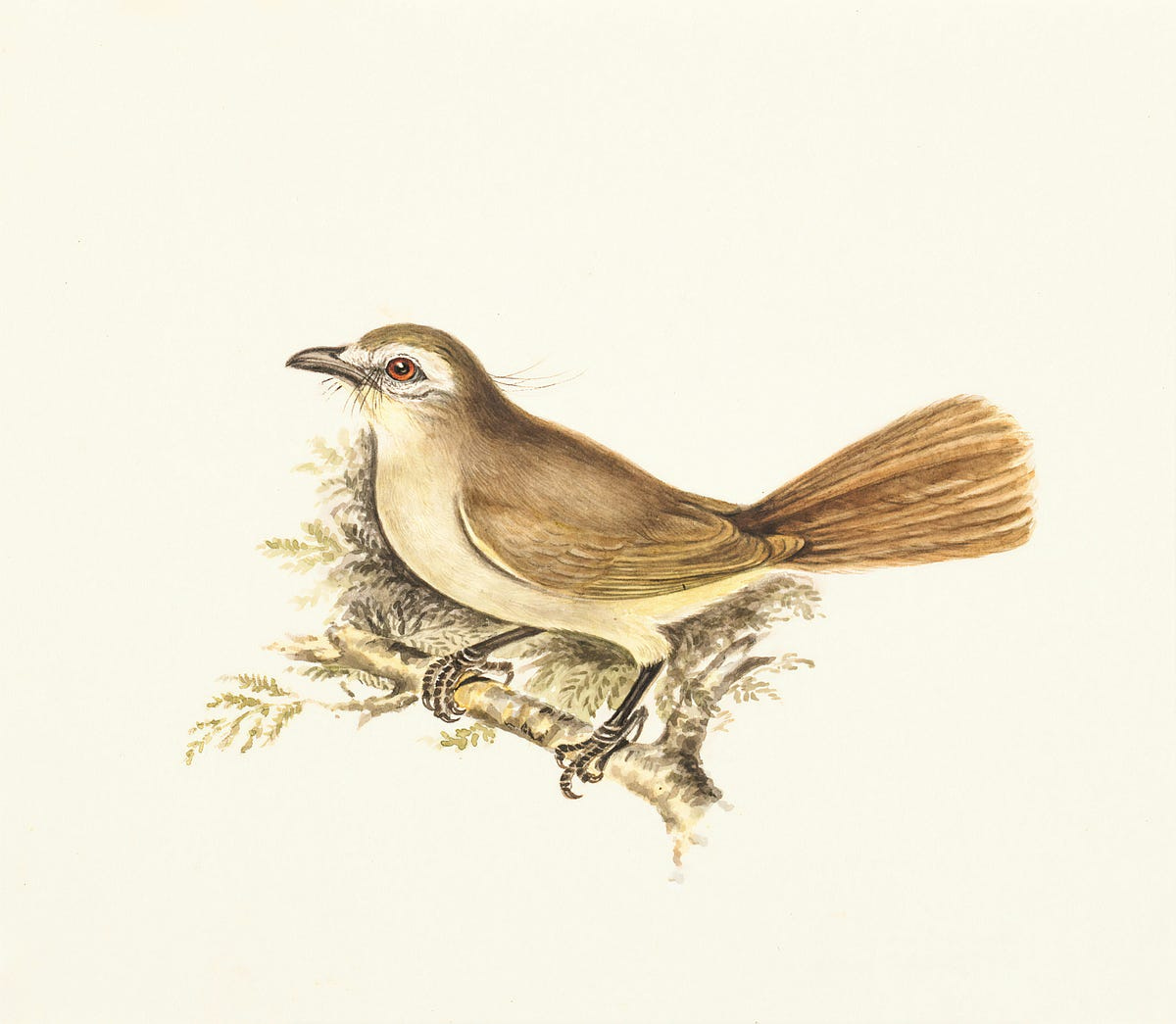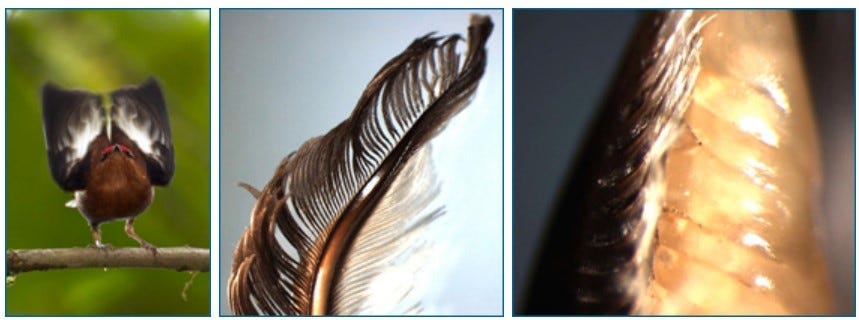
My favourite song by Mariah Carey is ‘Make It Happen’.
The song piles up to that climactic moment when the beats go silent, and she sings her heart out:
You can make it, make it happen
The club-winged manakin took these words seriously.
Manakins are some of the most amazing species of birds whose behaviours and courtship displays puts evolutionary theories on the hot seat. Richard Prum uses their beautiful ornaments and peculiar behaviour to explain the singular but often forgotten theory of sexual selection.
An overlooked version of the same theory is the role of mate choice. In particular, the mate decides, actively, what it prefers. Typically, it’s the female who selects who it prefers. In the case of the club-winged manakin, it plays by rules far from Natural Selection.
Natural Selection, a theory globally accepted in unearthing most biological phenomena, fails to explain how the club-winged manakin evolved to portray atypical behaviour and features as I shall elaborate.
To that effect, Jay-Z raps:
We livin’ in that 31st century
Indeed, the club-winged manakin lives in a world of its own, 31st century, oblivious of Neo-Darwinist claims.
That is power.
The power clap
The club-winged manakin can clap its wings at a speed of over 100 flaps per second. These rates are faster than the fastest hummingbirds. Such high rates are in the lower flap limit for insects. For comparison, the housefly can flap its wings at 200 flaps per second; the mosquito over 800 flaps per second.
It is not without good reason.
The club-winged manakin gets its name from the club-like ends at the tip of the sixth and seventh wings. Imagine holding a feather with hypertrophied ends; in the same way, a club is fatter and thicker on its end. These are features of the sixth and seventh secondary feathers.
The adjacent feather, the 5th, has a unique shape, taking a 45-degree turn as it tapers towards its tail end, unlike the hypertrophied form of the adjacent 6th and 7th feathers. By taking a tapering form, it acts like the pick used by guitarists.
When the wings are affixed in their normal position, this tapering turn of the 5th feather will overly the 6th and 7th wings. The 5th wing thus acts like a pick brushing over the combs — that is, the ribbed and hypertrophied parts of the 6th and 7th wing.
The clubs (6th and 7th feathers) act like a comb where the pick (5th feather) washes over the ribs like a single pick running through all the guitar strings. This movement produces a sound. With every flap of the wing, the clubs move through a ribbed portion of their wings to produce a unique male-generated sound.
Crickets produce sound in the same way. It has a pick and a ribbed ridge. With one flap of its wings, the pick runs through the ridges. Sound production when the pick runs through the ridges is called stridulation.
Without the capability of advanced technology, one would have thought that the bird produced this sound using its syrinx.
The syrinx is a unique organ found in birds that helps it to sing. Its close relatives, crocodylians, lack this distinguishing part in their respiratory system. In contrast, humans and other creatures have vocal cords in the larynx that help us to phonate and sing.
When performing its mating routine, the club-winged manakin does not use its syrinx — it uses its wings. Perched atop a branch, it leans down like a McLaren’s butterfly doors. It then flaps its wings to produce a sound that could rival Maria Carey’s high-pitched violin-like notes for a creature of its size.
The club-winged manakin hits the high C note, which is around 1500 cycles per second. How does it do this? Through the help of the pick-like form of the 5th feather, running over the ribbed portion of the 6th wing. These ribs are seven in number. With an average of 107 wing flaps per second, with a complete cycle including a to-and-fro direction, the clubs to through ribs twice (7×2=14). Now, fourteen times 107 gives you 1498 cycles per second.
Insane!
These movements are well described by the lines in the song, Power:
Now when I walk in, everybody do the “Power” clap
Clap, clap clap
Fresh for the club, I just took a half an hour nap
Clap, clap, clap

Wings were meant to flap and propel birds into the air. The faster the flaps, the easier it is to move aerodynamically like insects and hummingbirds. However, rather than use the syrinx, this bird uses its wings to produce its unique albeit beautiful sound with its wings.
Why?
The best explanation is mate choice. Females get to decide the kind of males they prefer and they can select the most extreme males — the ones who display ornate features that appeal to their tastes.
The extremes of these tastes are not only skin deep; they stretch all the way to the bone. The first feathered creatures are believed to have evolved these ornaments for the purposes of temperature regulation and later coopted them for flight.
While this is generally accepted as the preferred explanation, the evolutionary development of the feather shows that it could have initially begun as a means of regulating body temperature as a follicle turned tubular, and then later coopted for beauty before they were even used for flight.
Birds are the living remnants of theropod dinosaurs, who first walked the planet but also tasted the skies. Throwing caution to the wind would have been impossible without bone modifications to accommodate and streamline feather function. Thus, to facilitate aerobic lift, birds had to adjust their bones into hollow structures.
Also known as pneumatized bones, flying birds tend to have more air spaces inside bones than bone marrow to facilitate flight. The velociraptor, the ancient dinosaur we see in almost all Jurassic Park movies, was feathered. They too had pneumatized long bones.
The club-winged manakin, however, is made of solid bone through and through! You can sense the power in the air when it claps its wings.
Clap, clap, clap.
Furthermore, it has tubercles for the attachment of these powerful muscles. This anatomy is different from the other long bones seen in other manakins. It literally took the words of Mariah Carey, that is, ‘make it happen’, to revert 150 million years of ulnar morphology from the early theropod dinosaurs.

That’s not the end of it. This form should ideally be seen in the males who make elaborate mating displays. But these long bones form long before their sex is determined. The bone morphology, thus, becomes inherited by females as well!
Richard Prum calls this evolutionary decadence. Rather than improve and optimize for survival, the club-winged manakin underwent evolutionary decadence. Why opt for the wings rather than the syrinx? Why change bone morphology when it will tamper with your flight? Why subject the female to the same form when it doesn’t perform any mating ritual?
Of special note is that while the females inherit the external form of the long bones, they still develop pneumatized bones to aid in their flight. In short, the solid bone structure is an exclusive male feature. Or in the words of Jay-Z:
Man, you got the power to do anything you want to
Natural Selection works through gradual selection. This form of evolution is the complete opposite, reverting a 150 million-year bone structure.
No one meant to have all that power
An explanation from Organismal Selection
Sexual selection explains the runaway effect of ornaments to the point of contradicting Natural Selection’s adaptationist goals. It is a powerful force elaborated by the club-winged manakin.
The other theory that can explain such behavior, albeit from a different angle, is Organismal Selection (OS). This theory suggests that organisms seek mergers as the easiest go-to solution to avoiding annihilation.
For manakins, this is best formed when birds seek mergers by enhancing their mating practices. The manakins capable of showcasing the most elaborate displays win the ladies.
Ladies, plural because the males don’t participate in clutch rearing. They mate with as many females as they possibly can. All these are mergers.
What the club-winged manakin confesses is that organisms are willing to go to great lengths to establish these mergers, to the point of reversing 150 million-year-old structures. Flight is disregarded and so is the syrinx, the bird’s voice box. The result is the bird can form mergers with many female club-winged manakins.
All 54 species of manakins work to seek and preserve the mergers necessary for their survival, and in this case, it is preferred even if it affects the male’s flight ability.
The handicap principle, an explanation I once held close to heart, would have just as well explained this ‘anomaly’, but does not explain why the most extreme features are lacking in the wild. The club-winged manakin is a single example from the remainder 50+ species.
Furthermore, if the females also develop the same bone morphology as the males, is it really a cost for the males? Here, the handicap principle fails.
As simple as OS is, it also relies on the explanatory power of other theories to obtain relevance. In particular, physiology, anatomy, and biological behaviour. Once a function is understood, the roles can be explained using OS. These mergers are best understood using the simple rule of mergers:
The role of one serves the other and vice versa.
The role of the club-winged manakin mating ritual serves the female. This is an intricate form of service because it is the male’s admission of female dominance.
Female dominance is seen when they choose the male birds they like. In this case, it serves the birds who can change their entire anatomy to please the ladies — an admission of female autonomy. The strange anatomy serves the female’s aesthetic pleasures.
Thus, in return, the role of the female serves the male. They get to mate.
This is a stable merger.
And according to OS, organisms seek mergers. The stable ones survive. The unstable ones don’t. This one by the club-winged manakin is preserved down to the level of the bone. Natural Selection cannot explain such a leap in evolution. Maybe sexual selection.
But so does OS.
What I’m trying to say is…
No one is meant to have all that power.
Power to disregard the ‘almighty’ Natural Selection only for organisms to form mergers.
Certainly, if a solitary bird is capable of reversing and re-engineering its form counter to our understanding of evolution, it is a misfit. Evolutionary decadence shows a trend toward decay rather than improvement. Why? I stand by what my theory explains — the universal pressure to seek mergers.
It also flips the script by highlighting that it is only decadence relative to the theory of Natural Selection. It is not quite the case when viewed under the scope of OS.
It is my wish that a producer captures the melodious sounds this bird makes and samples it into a song, with Mariah Carey as a featured artist.
That would be a powerful song.
This song inspired some of the lines used in this article. Source — YouTube



